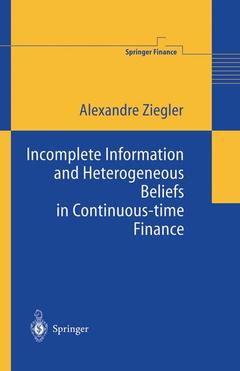Description
Incomplete Information and Heterogeneous Beliefs in Continuous-time Finance, Softcover reprint of hardcover 1st ed. 2003
Springer Finance Series
Author: Ziegler Alexandre C.
Language: English
Subjects for Incomplete Information and Heterogeneous Beliefs in...:
Incomplete Information and Heterogeneous Beliefs in Continuous-time Finance
Publication date: 10-2010
198 p. · 15.5x23.5 cm · Paperback
Publication date: 10-2010
198 p. · 15.5x23.5 cm · Paperback
Incomplete information & heterogeneous beliefs in continuous-time finance
Publication date: 02-2003
198 p. · 15.5x23.5 cm · Hardback
Publication date: 02-2003
198 p. · 15.5x23.5 cm · Hardback
Description
/li>Contents
/li>Comment
/li>
Continuous-time finance was developed in the late sixties and early seventies by R. C. Merton. Over the years, due to its elegance and analytical conve nience, the continuous-time paradigm has become the standard tool of anal ysis in portfolio theory and asset pricing. However, and probably because it was developed hand in hand with option pricing, in which investors' expecta tions were thought not to matter, continuous-time finance has for a long time almost entirely neglected investors' beliefs. More recently, the development of martingale pricing techniques, in which expectations playa dominant role, and the blurring boundary between those methods and the original methods of continuous-time finance based on the Ito calculus, have allowed expecta tions to regain their central role in finance. The habilitation thesis of Professor Alexandre Ziegler is entirely devoted to the role of expectations in continuous-time finance. After a brief review of the literature, the author analyzes the consequences of incomplete informa tion and heterogeneous beliefs for optimal portfolio and consumption choice and equilibrium asset pricing. Relaxing the assumption that investors can ob serve expected dividend growth perfectly, the author shows that incomplete information affects stock prices and their dynamics, thus providing a potential explanation for the asset price bubble of the late 1990s. He also demonstrates how the presence of heterogeneous beliefs among investors affects their opti mal portfolios and their optimal consumption patterns.
1 Incomplete Information: An Overview.- 1.1 Introduction.- 1.2 Portfolio Choice.- 1.3 The Term Structure of Interest Rates.- 1.4 Equilibrium Asset Pricing.- 1.5 Conclusion and Outlook.- 2 The Impact of Incomplete Information on Utility, Prices, and Interest Rates.- 2.1 Introduction.- 2.2 The Model.- 2.3 Equilibrium.- 2.4 Logarithmic Utility.- 2.5 Power Utility.- 2.6 Information, Utility, Prices, and Interest Rates: A Synthesis.- 2.7 Time-Varying Parameters.- 2.8 Conclusion.- 3 Optimal Portfolio Choice Under Heterogeneous Beliefs.- 3.1 Introduction.- 3.2 The Model.- 3.3 The Deviant Agent’s Problem.- 3.4 Optimal Portfolio Choice.- 3.5 An Example.- 3.6 Conclusion.- 4 Optimal Consumption Under Heterogeneous Beliefs.- 4.1 Introduction.- 4.2 The Cox-Huang Methodology.- 4.3 Heterogeneous Beliefs.- 4.4 An Example.- 4.5 Portfolios and Consumption: A Synthesis.- 4.6 Conclusion.- 5 Equilibrium Asset Pricing Under Heterogeneous Beliefs.- 5.1 Introduction.- 5.2 The Model.- 5.3 Equilibrium Consumption.- 5.4 Equilibrium Prices.- 5.5 Implied Risk Aversion.- 5.6 Conclusion.- 6 Costly Information, Imperfect Learning, and Information Aggregation.- 6.1 Introduction.- 6.2 The Model.- 6.3 Portfolio Choice under Costly Information.- 6.4 Equilibrium Asset Pricing.- 6.5 Information Aggregation and the Equity Premium.- 6.6 Conclusion.- 7 Summary and Conclusion.- C The Short Rate Under Heterogeneous Beliefs.- References.- List of Figures.- List of Tables.- List of Symbols.
Heterogenous beliefs are an important factor in pricing financial assets. This book shows the impact of heterogenous beliefs on investor's portfolio, consumption behavior and on equilibrium asset prices. Includes supplementary material: sn.pub/extras
© 2024 LAVOISIER S.A.S.
These books may interest you

Financial Asset Pricing Theory 67.55 €



